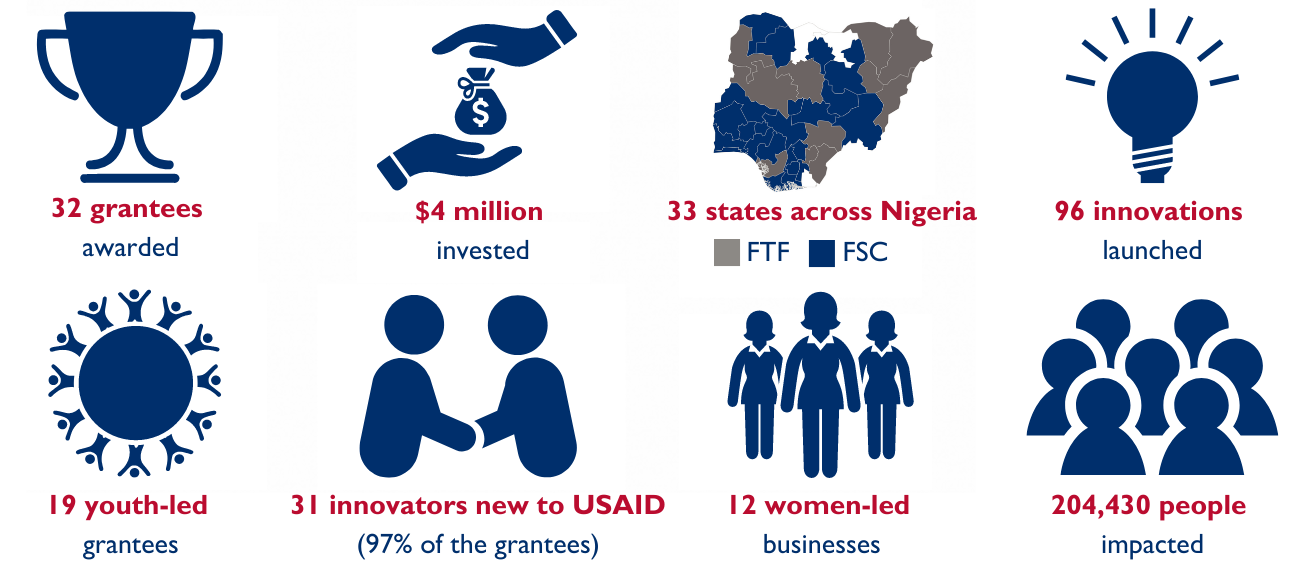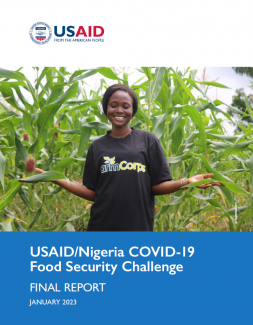The Problem
Nigeria is the most populous country in Africa, and roughly 70 percent of the population lives below the poverty line. Agriculture is a mainstay of the national economy, as roughly two-thirds of the total labor force works in agriculture, yet the country still depends on imports of grain, livestock, and fish to meet local demand. Hunger and malnutrition are widespread. The Government of Nigeria reports that 37 percent of children under the age of five suffer from stunting linked to malnutrition.
The country’s economic progress and food security are constrained by complex, intersecting barriers; conflict and insurgent activities in the northeast have disrupted local production and supply chains and displaced over three million people. The pressures of climate change also threaten the resilience of the country’s agricultural sector, with droughts and floods heightening vulnerability.
COVID-19 accentuated pre-existing fault lines in the country’s supply chains and agricultural sector. The International Food Policy Research Institute estimated that there was a 13.1 percent loss of output in the country’s agriculture sector related to COVID-19 restrictions and preventative measures. Farmers struggled to access seeds and other inputs, and losses in the agro-processing sector were also significant at the height of the pandemic. Micro-, small-, and medium-sized enterprises (MSMEs) across the country’s food system struggled to stay in business, with a majority experiencing large drops in production.
The Response
Through Feed the Future (FTF), the United States Agency for International Development (USAID) works in 11 states of Nigeria and across six value chains. Over the last decade, FTF and partners have made significant strides with activities designed to reduce poverty, promote agriculture-led economic growth, improve nutrition, and strengthen household resilience.

To boost food production, USAID sought a new mechanism to rapidly channel much-needed support to local MSMEs. In February 2019, USAID/Nigeria approached USAID’s Exploratory Programs and Innovation Competitions (EPIC) team and the USAID Catalyst Project to consider an open innovation competition. From October 2021 to December 2022, the COVID-19 Food Security Challenge quickly deployed funding to 32 promising Nigerian MSMEs to adapt and scale their business models to improve the accessibility and affordability of food, leading to increased incomes for smallholder farmers.
Learn more about the 32 innovators here.
The Impact
During the 15-month challenge, 32 grantees introduced 96 unique innovations, technologies, products, and approaches for food production, processing, storage, and distribution—exceeding the project’s target by 100 percent. In many cases, these solutions used technology to create new linkages and efficiencies in agricultural value chains. Some grantees focused on demonstrating new production practices that increase yields, and others used challenge funds to bring new products to market. Nine grantees have received or are in the final stages of receiving certification from Nigeria’s National Agency for Food and Drug Administration and Control to sell their food products on a greater scale.
Ultimately, the innovations produced by the challenge have impacted the lives of 204,430 people, 26 percent of whom were women.

Food Security Impact
The challenge engaged across seven key impact categories for food security.
- Expanded access to inputs and mechanized farming: Grantees connected Nigerian farmers to the equipment, tools, and inputs they need to increase yields and incomes.
- Improved management practices for increased on-farm productivity. Grantees boosted agricultural yields and productivity across multiple value chains through the adoption of 96 new approaches and technologies for improved on-farm management.
- Increased market potential through improved agro-processing. Grantees brought a focus on value-added processing, helping farmers expand the earning potential of their crops.
- Reduced post-harvest losses through improved storage. Grantees introduced various solutions to help farmers better preserve and store crops, which resulted in more products getting to market and allowed farmers to maximize profit by selling when the price is right.
- Strengthened market linkages. Grantees connected farmers to new markets, buyers, and end users to unlock higher, more stable incomes for farming communities, including engaging 3,856 individuals in micro-finance or group savings initiatives.
- Increased sustainable production and environmental resiliency. Grantees approached environmental sustainability as an integral investment in resilience and self-reliance. As a result, over 7,800 smallholder farmers began using climate-smart approaches.
- Improved nutrition. Grantees strengthened local value chains for nutritious staples, filled key gaps in the agricultural ecosystem, and boosted the productivity and purchasing power of farming communities.
Grantee Business Impact
Grantees’ impact on food security can only be sustained if the businesses themselves are stable and well-positioned for growth. The challenge supported grantees to strengthen their enterprises, solidifying and scaling their models in a challenging private sector landscape.
- Increased incomes for men and women at the base of the pyramid (BOP).
- Direct employment. All 32 grantees hired new staff as they grew their businesses with challenge funds. A total of 629 new jobs were created.
- BOP incomes and cost savings. All 32 grantees worked to increase BOP incomes in farming communities—either directly or by unlocking cost savings for farmers. Farmers saw increases in incomes ranging from 14 to 100 percent.
- Increased challenge winners’ capacity to implement and sustainably scale solutions.
- New partnerships. At the portfolio level, grantees established 170 new partnerships with companies and institutions, exceeding their target for external partnerships by 133 percent. These partnerships unlocked finance and strengthened and scaled their business models, products, and geographic reach.
- New finance and growth activities. Grantees raised nearly $4.7 million in additional equity and debt financing from the private sector, exceeding the initial target by 70 percent.
Resources
- Learn more about the challenge in the final report
- Read some of the impact highlights from the challenge in the fact sheet
- Learn more about the 32 innovators from this challenge
- Read the closed Request for Applications to understand the application process and requirements

